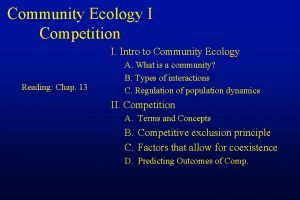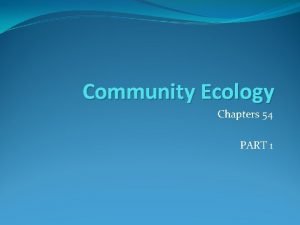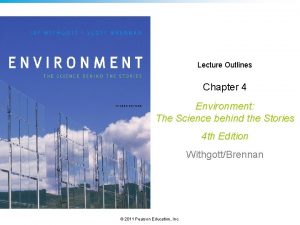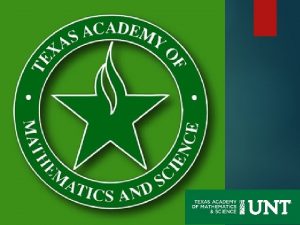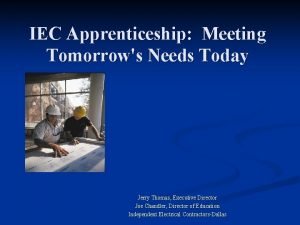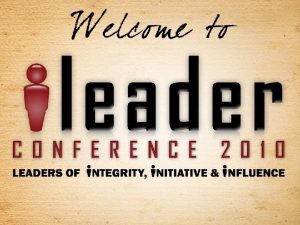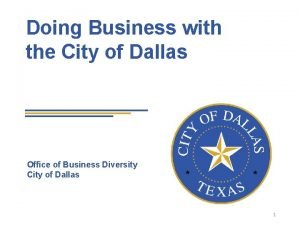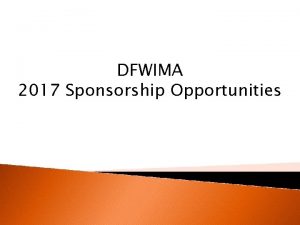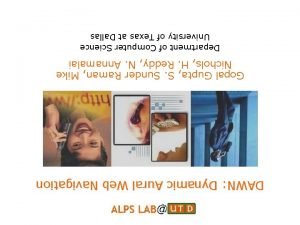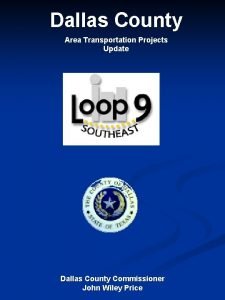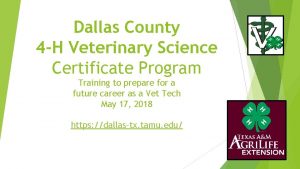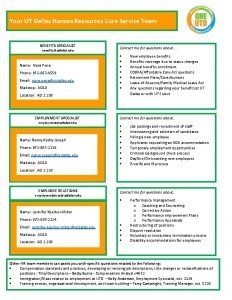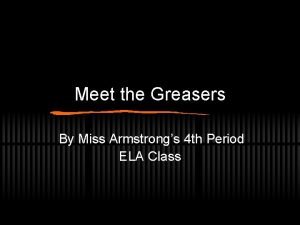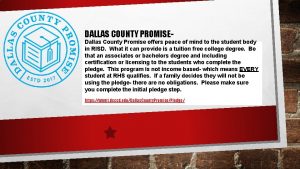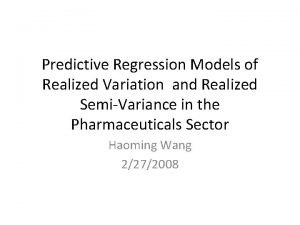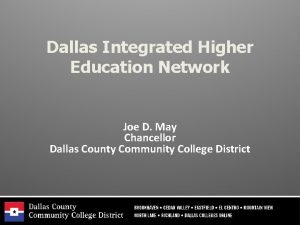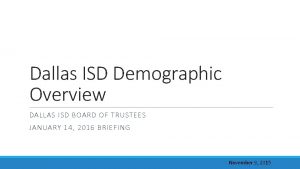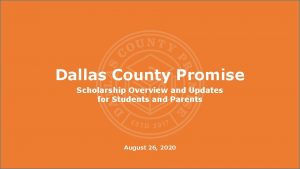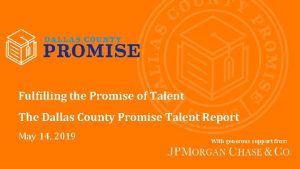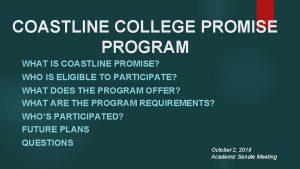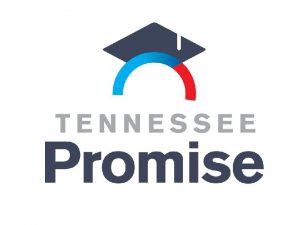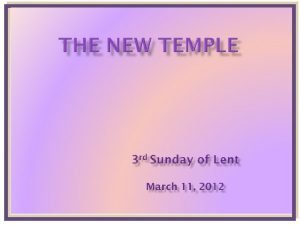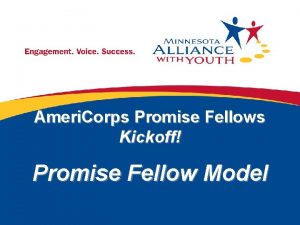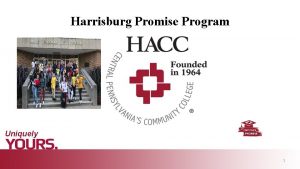The Dallas Promise Network Realized Joe D May




















- Slides: 20

The Dallas Promise Network Realized Joe D. May – Chancellor 1

For many low-income young people, colleges today are perceived to be too expensive, inflexible, culturally foreign and disconnected from requirements of work. The Challenge As a result, only 35% of high school graduates from the lowest-quartile social and economic status are earning any kind of postsecondary credential, compared to 72% of students from the highest quartile. With the rise of AI and automation, this large and persistent postsecondary attainment gap will mean even greater gaps in social mobility in the coming years. 2

The Solution: College Promise Programs … Allow students to start and complete a community college education without taking on student debt. It is a commitment to fund a college education for every eligible student, advancing on the path to earn a degree, a certificate and/or credits that transfer to a four-year university. 3

Building a Network to Address Inequity & Income Disparity Whether first dollar programs – covering the cost of tuition before applying Pell Grants or other aid, or last dollar programs the goals are the same: • Removing friction and barriers for first-generation students coming from low socio-economic backgrounds. • It is about owning a space that no one seems to own – the transition between high school and college. • As we built the Dallas Promise Network, we discovered that friction occurs at each handoff point and too many students are unsuccessful in making the transition. • The definition of a network means that we must connect and collaborate with partners in different ways to ensure student success. 4

Work is Too Big For Any One Institution or Organization The Dallas Promise Network: • 53 high schools representing 12 school districts • Almost 80 employers working with P-Tech high schools enabling thousands of students to be on a career pathway leading to certificates, associate degrees and bachelor degrees • Providing success coaches and navigators • Partnering with regional universities • Partnering with non-profits to address hunger, mental health, transportation, and emergency aid • Philanthropic community fully engaged 5

New Technologies are Needed to Remove Friction Between Systems • Virtually all education software is designed to operate within an institution, not between institutions and organizations. • This is one of the reasons that no one owns student transitions and handoffs. • Autonomy is the enemy, education needs new tools to facilitate collaboration and remove friction from student facing processes. 6

Network Strategy Solving the talent problem will take the entire community to address the equity and poverty challenge. Every dotted line represents a handoff and a point of failure for our most vulnerable students.

Increased Student Access through High School Transformation Which demonstrates strong initial results across all indicators 8

P-TECH • 9 th through 12 th grade program that allows them to earn an associate degree or up to 60 college credit hours in a STEM related field concurrent with their high school degree. • Students graduate with both a high school diploma and an industry-recognized associate degree, in addition to gaining relevant workplace skills and industryrecognized certifications. • Requires a minimum of 2 employers engaged with every early college high school, career academy, or P-TECH high school. 9

Dallas Promise Network Model • The Dallas County Promise forms partnerships with high schools that require the following: • Students coming out of the 8 th grade are informed of the necessary steps and expectations to prepare for college. • The school districts provide boot-camps between the 8 th grade and 9 th grade to focus on preparing students for success in the 9 th grade. • During the 9 th grade year, along with the students regular studies, they receive intense support for increasing their reading skills. • During the 10 th grade year, they receive the same type of support for writing skills, and during the 11 th grade year, they are provided similar support in mathematics. 10

continued, • During the 11 th and 12 th grade years, they will earn a minimum of 15 semester hours of college credit. • Each year, students will receive mentorship from business partners and have an opportunity for internships during their 11 th and 12 th grade years. • During the senior year, they will complete the Dallas County Promise Pledge to attend college, complete the FAFSA, and enroll in college. • Once in college, students may attend tuition free, receive case management support by the colleges, and are guided toward partner universities and/or employers to help ensure their upward mobility. 11

Three Simple Steps q Pledge SENIOR YEAR by February 8: • Make your Promise Pledge at www. Dallas. County. Promise. org • Your pledge is only complete once you see a submission confirmation q Apply SENIOR YEAR by March 8: • Complete application to DCCCD through Apply. TX or the DCCCD Admissions Application • Submit Free Application for Federal Student Aid (FAFSA) or Texas Application for State Financial Aid (TASFA) and list DCCCD college q Enroll SENIOR YEAR by July 31: • Complete DCCCD Registration for Fall semester 12

In Promise Cohort 1 We discovered the Key Factor: Complete the FAFSA 2016 • % Economically Disadvantaged Samuell 99% Madison 98% N. Dallas 95% Sunset 94% Adamson 93% SOC 93% Molina 91% Seagoville 90% Lincoln 90% 89% Bryan Adams Trini Garza 88% Pinkston 87% T. Jefferson 86% Wilmer-Hutchins 86% Gilliam 83% Spruce 83% Conrad 81% Grand Prairie 80% Lassiter 80% Kimball 80% Carter 79% Roosevelt 78% Lancaster 77% Hillcrest 76% Early College 76% WT White 63% De. Soto 61% Lakeview 59% S. Grand Prairie 56% Cedar Hill 43% Cedar Hill Coll. 2016 • % FAFSA Completion 31% 58% 47% 49% 56% 51% 2016 • % TX Enrollment 61% 40% 52% 56% 30% 38% 40% 44% 41% 36% 43% 30% 39% 44% 60% 58% 31% 63% 70% 49% 44% 64% 48% 43% 65% 26% 35% 42% 73% 29% 34% 45% 74% 45% 44% 52% 44% 65% 52% 53% 46% 55% 60% 81% 34% 46% 72% 47% 52% 57% 50% 73% 13

Dallas Promise Network Serves… Free tuition to any DCCCD college 16, 0000 SENIORS 43 HIGH SCHOOLS 10 SCHOOL DISTRICTS

The Difference Between Jonathan & His Brother: Equity in College & Workforce Outcomes Jonathan Herrera Mountain View College Software Engineering His Inspiration: His brother who likes computers, but didn’t get to attend college because of cost. “My Promise Career Mentor has been encouraging me and inspiring me to learn more about my career field. He gave me this thick book about Javascript. He also gave me a Raspberry Pi so I could start making little projects on the side. ” The Dallas Promise Network and Greenlight Technology Provide: Identifying Jonathan’s Skills and Interests Matching Jonathan to a program of study Ensuring a freetuition college pathway to a job Matching Jonathan’s skills and program to an employer Matching Jonathan to a career mentor at the employer 15

Cohort 2 Ranked #2 in the US for Financial Aid Completion Adding $4. 5 M NEW PELL Dollars for Dallas County Students 16

Dallas County Promise Cohort 3 will be larger than 17 U. S. States and represents the largest PTECH/ECHS implementation in the country. Over 22, 000 High School Seniors Larger than 17 US States 41 PTECH | ECHS Schools Largest Rollout in U. S. 72 Industry Partners and Growing 17

Funding Model Fosters P-TECHs / ECHS/ Promise / Innovation How the model works: • No cost to students or parents • Local property tax revenue used to meet P-TECH no cost to students legislative requirement. • Starting New PTECHs/ECHS • Cost to DCCCD is $750, 000 each • Expanding the Promise • Adding 10 PTECHs per year • Serving 107 high schools throughout Dallas County • Promise Efforts • To address educational and economic disparity in Dallas County 18

63 student-parent pairs are attending DCCCD with the Parent Promise • Students “gift” Promise to Parents “To see her do it and pursue it, it really inspires me. ” • Programs lead to $24/hr jobs • 25 Associate Degree Programs • 25 Certificate Programs “I wanted to show Mya that I can do it. ” 19

Thank You 20
 Born on may 12, 1914, in dallas, texas.
Born on may 12, 1914, in dallas, texas. Fundamental and realized niche
Fundamental and realized niche Can a realized niche be larger than a fundamental niche
Can a realized niche be larger than a fundamental niche Realized niche
Realized niche Realized eschatology definition
Realized eschatology definition Hypothetical meaning exercises
Hypothetical meaning exercises Realized niche
Realized niche Tams tracks
Tams tracks Progressive era
Progressive era Dallas winston personality traits
Dallas winston personality traits Iec dallas pay scale
Iec dallas pay scale President of dallas theological seminary
President of dallas theological seminary Doing business in dallas
Doing business in dallas Dfwima
Dfwima Venacure dallas
Venacure dallas Loop 9 schematics
Loop 9 schematics Veterinary radiology dallas county
Veterinary radiology dallas county Ut dallas human resources
Ut dallas human resources Dallas crown horse slaughter plant
Dallas crown horse slaughter plant Dallas midwife associates
Dallas midwife associates The greasers personality traits
The greasers personality traits


